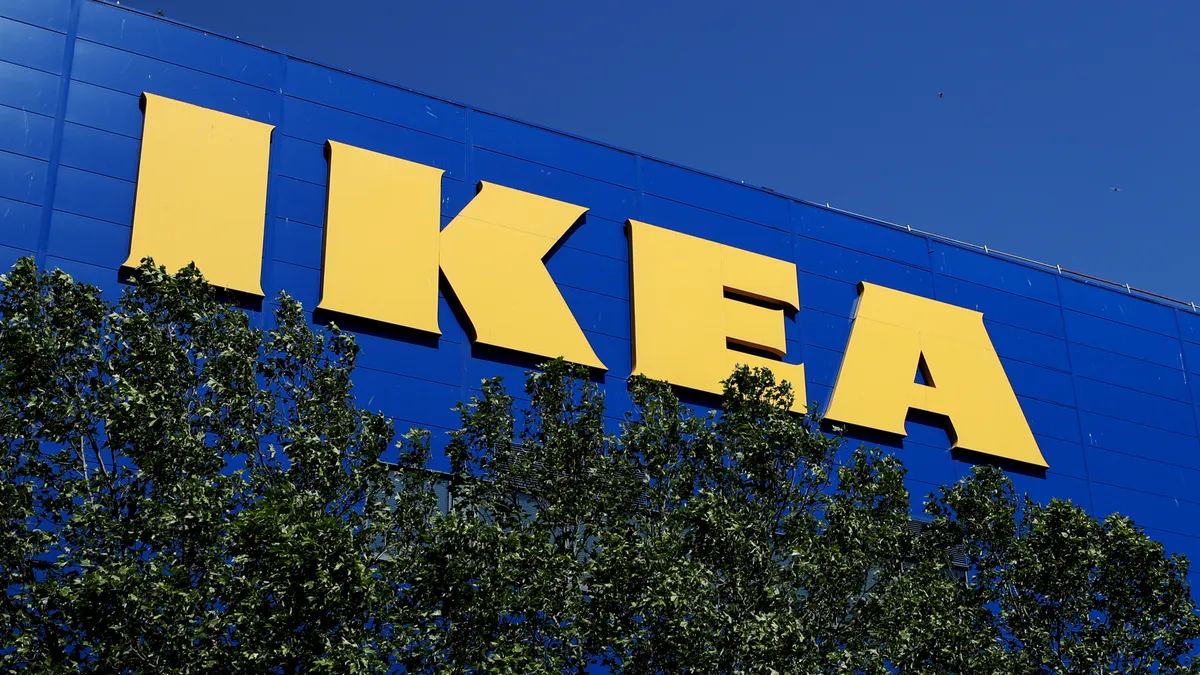Dive Brief:
- Ikea said last week it had reduced its total climate footprint by 22% compared to a 2016 baseline, and by 12% compared to the previous year. The company attributed the decline to an increase in renewable electricity at both retail and production units, improving energy efficiency in its lighting range and lower production volumes.
- The Swedish manufacturer produced approximately 24.1 million tons of carbon dioxide equivalent in the fiscal year 2023. Its sustainability report said the largest portion of those emissions — 46.6% — came from the extraction and processing of raw materials, followed by the use of its products in customers’ homes — 15.9% — including the energy consumption of lighting and appliances.
- The company’s greenhouse gas emissions, which were detailed in Ikea’s separate climate report, also declined by 11.5% from the previous year: scope 1 dropped by 21.6% and scope 2 dropped by 24.8%. Scope 3 emissions — which accounted for the bulk of emissions — dropped by 12.7%, when calculated by adding all 15 criteria laid out in the report for FY2022 and FY2023.
Dive Insight:
The home furnishings retailer said it updated its climate strategy by developing “rigorous action plans” in line with the Science Based Targets initiative net-zero standard and a global target of keeping temperature rise below 1.5°C. The new goals include halving greenhouse gas emissions from Ikea’s supply chain by 2030, compared to a 2016 baseline, and reaching net-zero status by 2050, at the latest. The updated strategy, which the retailer said it had submitted to SBTi for approval in November, builds on Ikea’s initial aim to become climate positive by 2030.
Pär Stenmark, chief sustainability officer at the Inter IKEA Group, said in the release it was important to act with urgency and stay committed to the Paris Agreement given the world is off track in terms of meeting its global warming targets.
“To further support change, the IKEA business advocates for a complete phase out of fossil fuels and its subsidies, halting deforestation and addressing the root causes of air pollution,” Stenmark said.
In addition to updating its target for greenhouse gas emissions reduction, Ikea also set new decarbonization goals. The company said it aims to incorporate the Land Sector and Removals Guidance from the World Resources Institute and World Business Council for Sustainable Development-backed GHG Protocol, once it is finalized. The accounting guidance explains how companies should account for and report greenhouse gas emissions and removals from land management, land use change, carbon dioxide removal technologies, biogenic products and other related activities. The guidance is expected to be finalized later this year.
Other than updating its climate action strategy across its own operations, Ikea also said it will aim for additional reductions in society by taking an “extended responsibility” for the climate footprint of its customers, suppliers and areas it sources its materials from. The company said it will set a goal for this once the Land Sector and Removals Guidance is ready.
Though Ikea did increase its renewable electricity production — with 142 additional factories or suppliers using 100% renewable electricity — the company also disclosed its use of coal consumption increased slightly in 2023 “presenting a challenge to address” in the upcoming year. The retailer also noted that its renewable energy production remained stagnant at 48% mainly due to a significant decrease in the use of biofuel related to the shut-down of its production facilities in Russia.
The company’s revised climate strategy follows the launch of two sustainability initiatives it announced last year, which included a solar installation project and renewable heating and cooling schemes across multiple units and stores in the United States.
















